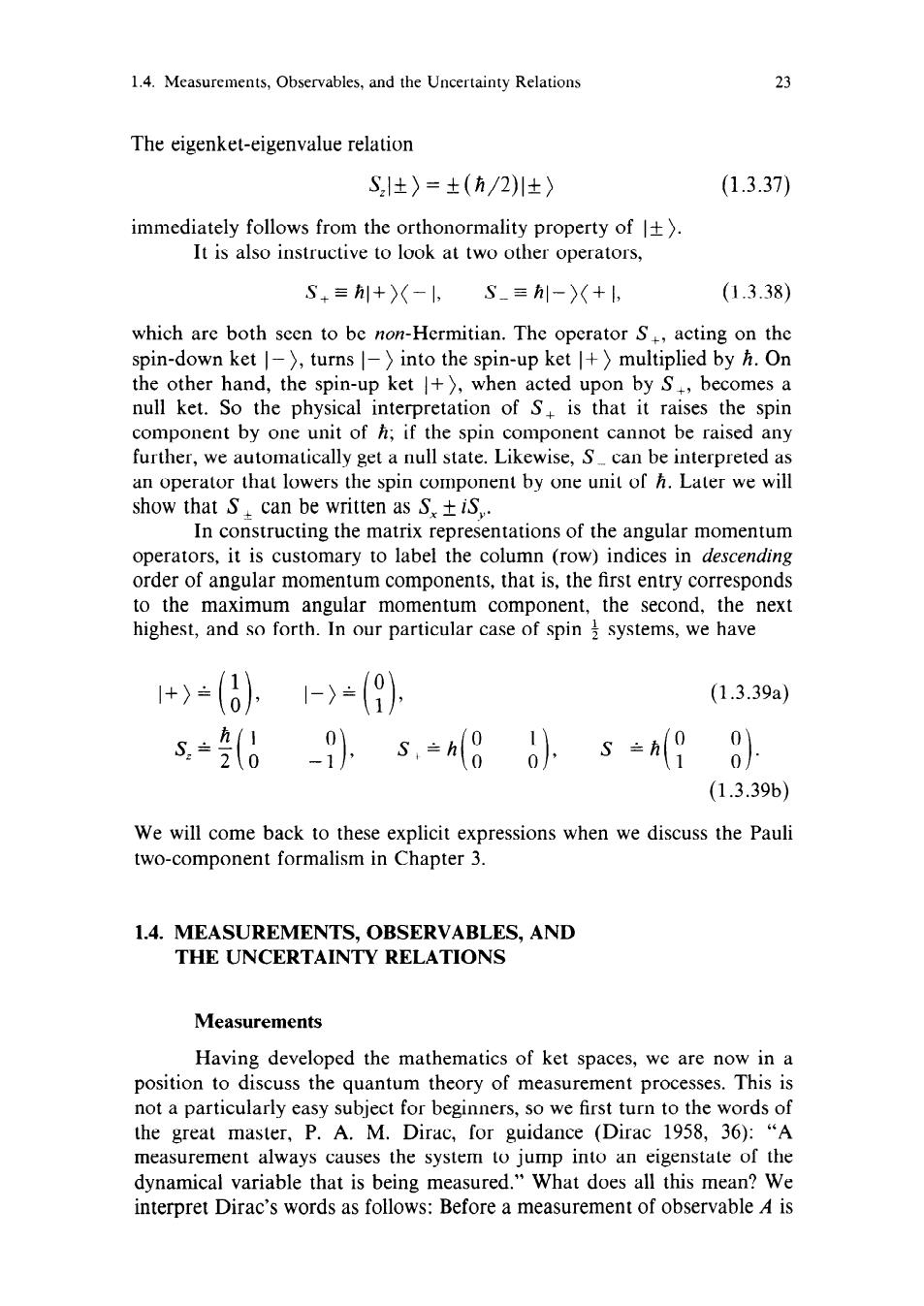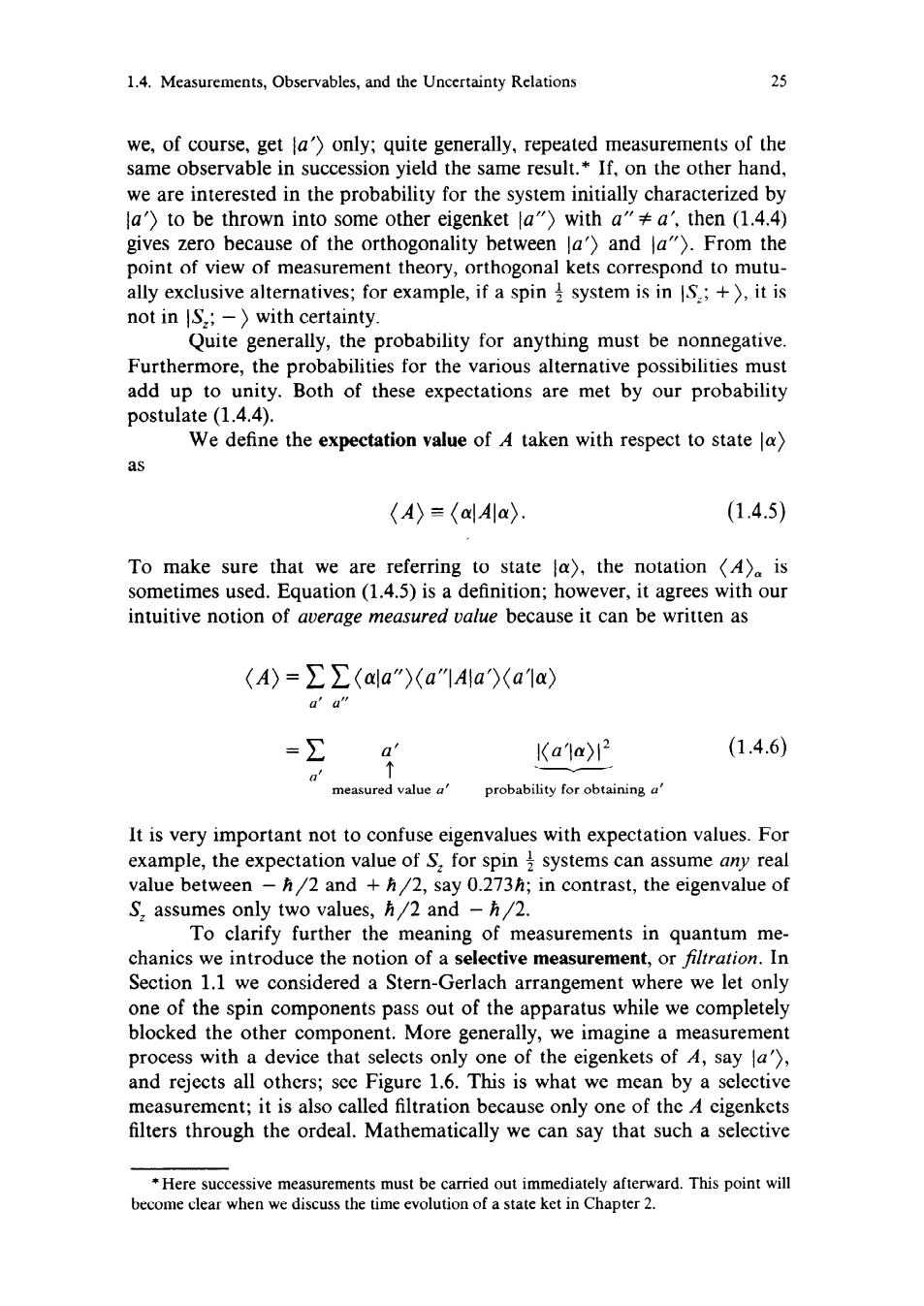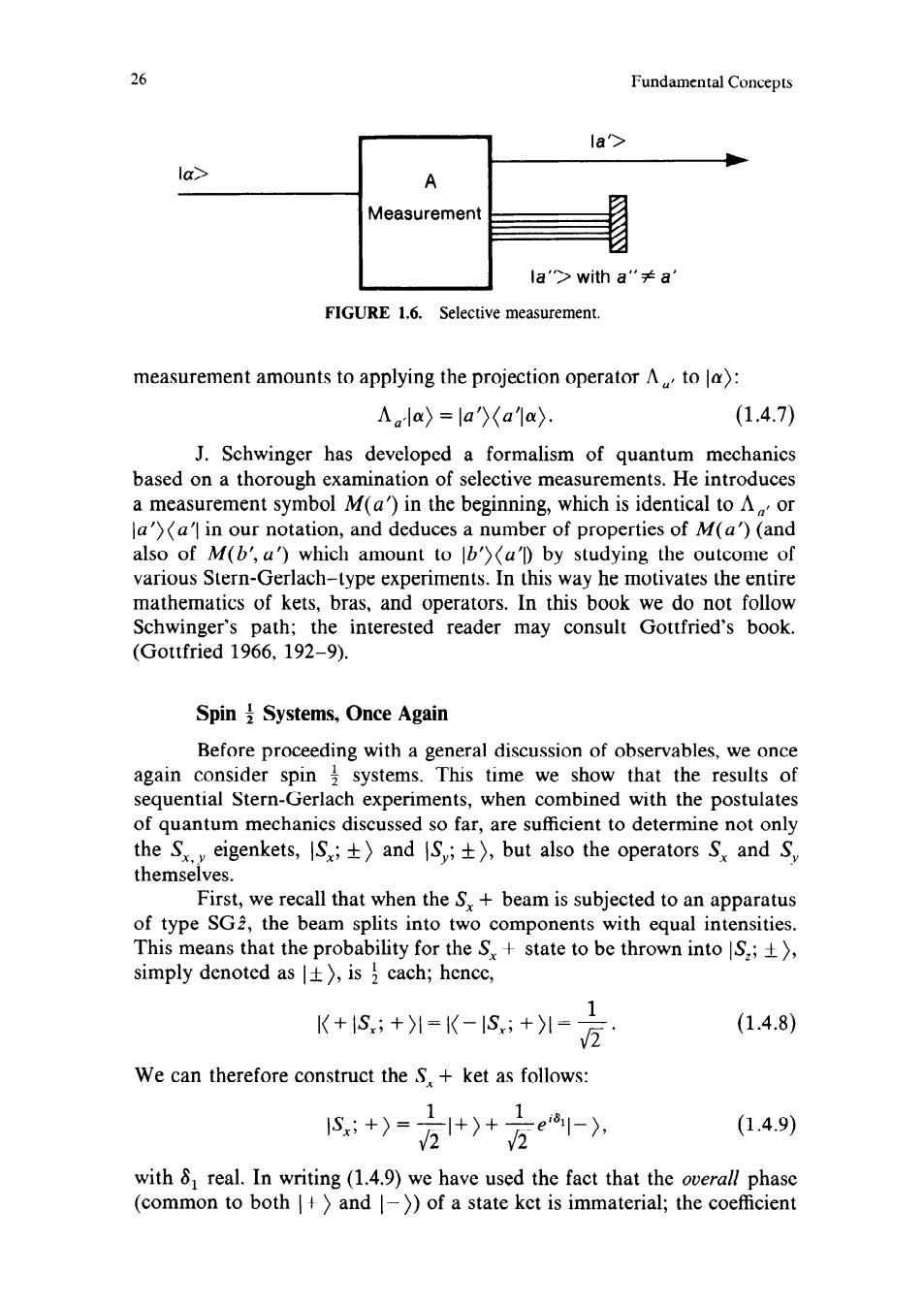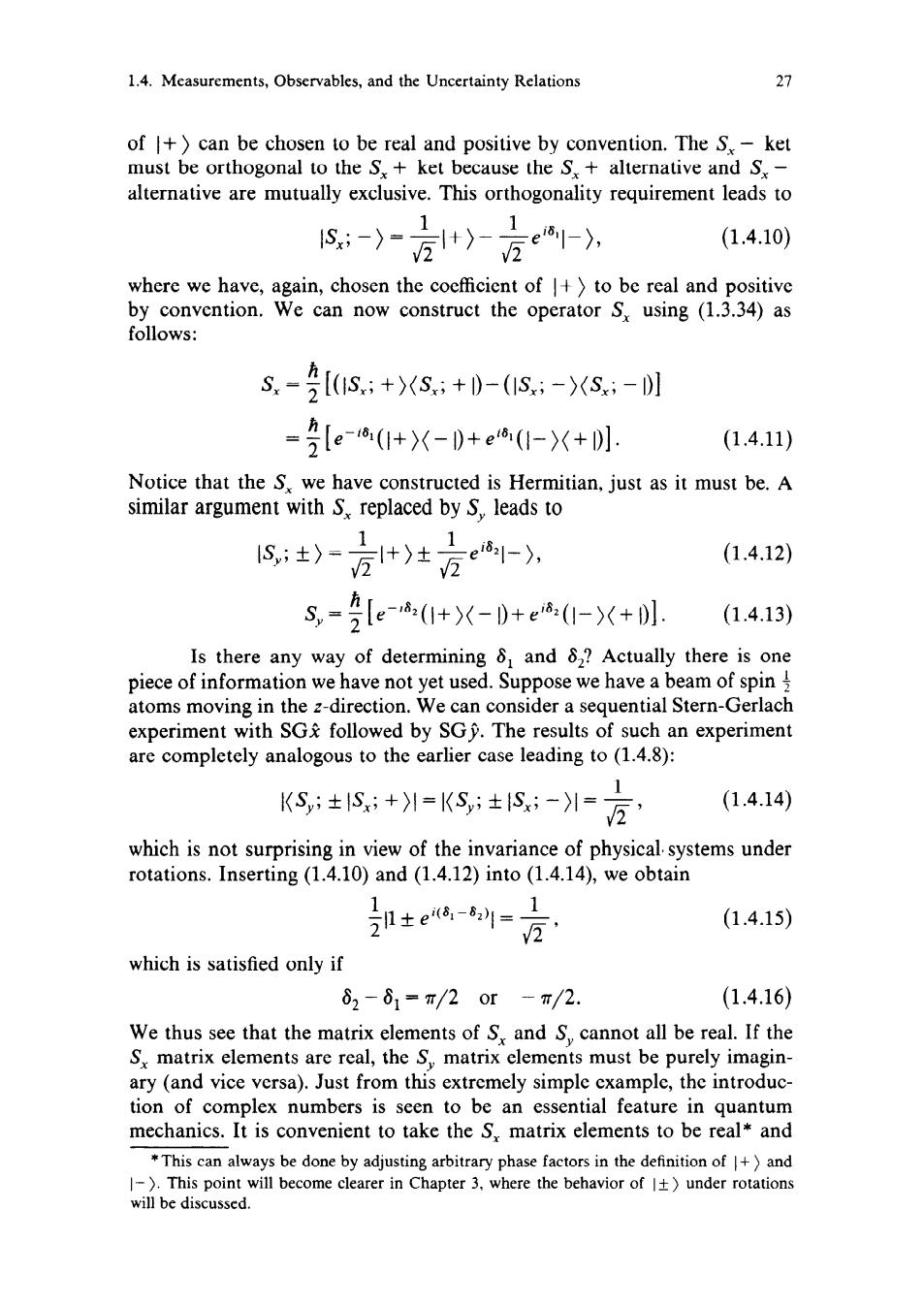
1.4.Measurements,Observables,and the Uncertainty Relations 23 The eigenket-eigenvalue relation S1±)=±(方/2)川±)》 (1.3.37) immediately follows from the orthonormality property oft It is also instructive to look at two other operators, S+=+)(-,S_三川-)(+, (1.3.38) which are both seen to be non-Hermitian.The operator S,acting on the pin-down ket turnsinto the spin-up ket multiplicd by h.On other hand the spin-up ket +)when acted upon by S.,becomes a null ket.So the physical interpretation of S,is that it raises the spin component by one unit of h;if the spin component cannot be raised any further,we automatically get a null state.Likewise,S_can be interpreted as an operator that lowers the spin component by one unit of h.Later we will show that S±can be written as S.±iS,. In constructing the matrix representations of the angular momentum operators,it is customary to label the column (row)indices in descending order of angular momentum components.that is.the first entry corresponds to the maximum angular momentum component.the second,the next highest,and so forth.In our particular case of spin systems,we have +)=(0 (. (1.3.39a) 30-)S.=8 8 (1.3.39b) We will come back to these explicit expressions when we discuss the Pauli two-component formalism in Chapter 3 1.4.MEASUREMENTS,OBSERVABLES,AND THE UNCERTAINTY RELATIONS Measurements Having developed the mathematics of ket spaces,we are now in a position to discuss the quantum theory of measurement processes.This is not a particularly easy subject for beginners,so we first turn to the words of the great master,P.A.M.Dirac,for guidance (Dirac 1958,36):"A measurement causes the system to ump into an eige nstate of the dynamical variable that is being measured.What doesal thismean?We interpret Dirac's words as follows:Before a measurement of observable A is

24 Fundamental Concepts made,the system is assumed to be represented by some linear combination 1a〉=∑cla)=∑la)(a1a) (1.4.1) When the measurement is performed,the system is"thrown into"one of the eigenstates,say a of observable A.In other words. la) measurement'). (1.4.2) For example,a silver atom with an arbitrary spin orientation will change into either+)or-when subjected to a SG apparatus of type SG2.Thus a measu rement usually changes the state.The ly exception when the state is already in one of the eigenstates of the observable being measured,in which case (1.4.3) with certainty,as will be discussed further.When the measurement causes la)to change into la',it is said that A is measured to be a'.It is in this sense that the result of a measurement yields one of the eigenvalues of the observable being measured. Given (1.4.1).which is the state ket of a physical system before the measurement,we do not know in advance into which of the various la''s the system will be thrown as the result of the measurement.We do postulate.however.that the probability for jumping into some particular la')is given by Probability for a'=Ka]a)2 (1.4.4) provided that la)is normalized. Although we have been talking about a single physical system,to determine probability (14.)empirically,we must consider a great number of measurements performed on an ens that 1,a collection identically prepared physical systems,all characterized by the same ket la). Such an ensemble is known as a pure ensemble.(We will say more about ensembles in Chapter 3.)As an example,a beam of silver atoms which vive the first SG apparatus of Figure 1.3 with the S. component blocked is an example of a pure ensemble because every member atom of the ensemble is characterized by S,;+). The probabilistic interpretation(1.4.4)for the squared inner produet 2is one of the fundamental postulates of quantun mechanics,so it cannot be proven.Let us note,however,that it makes good sense in extreme cases.Suppose the state ket is la itself even before a measurement is made;then according to(1.4.4),the probability for getting a'-or,more precisely,for being thr n into la八 s the sult of the measuremen predicted to be 1,which is just what we expect.By measuring A once again

1.4.Mecasurements,Observables,and the Uncertainty Relations we,of course,get la')only;quite generally,repeated measurements of the same observable in succession yield the same result.*If,on the other hand. we are interested in the probability for the system initially characterized by la')to be thrown into some other eigenket la")with a"#a,then (1.4.4) gives zero because of the orthogonality between la')and la").From the point of view of measurement theory,orthogonal kets correspond to mutu- ally exclusive ateratives;for example,if a spinsystem is in+).it is not in IS.: )with certainty. Quite generally,the probability for anything must be nonnegative. Furthermore,the probabilities for the various alternative possibilities must add up to unity.Both of these expectations are met by our probability postulate(1.4) We define the expectation value of 4 taken with respect to state a) as 〈A)=(aAa〉 (1.4.5) To make sure that we are referring to state la),the notation (is sometimes used.Equation (1.5)isa definition:however.it agrees with ou intuitive notion of average measured value because it can be written as (A)=>>(ala")(a"lAla(ala) =∑ Kaa)12 (1.4.6) measured value a' probability for obtaining a It is very important not to confuse eigenvalues with expectation values.For example,the expectation value of S.for spin systems can assume any real value between -h/2 and +h/2,say 0.273h;in contrast,the eigenvalue of S.assumes only two values,h/2 and -h/2. To clarify further the meaning of measurements in quantum me chanic eintroduce the notion of a sele tive measurement, or filtration. Section 1.1 we considered a Stern-Gerlach arrangement where we let only one of the spin components pass out of the apparatus while we completely blocked the other component.More generally,weimagine a measurement with a device th selects of the eigenkets of 4,say and rejects all others;sce Figure 1.6.This is what we mean by a selective measurement;it is also called filtration because only one of the A eigenkets filters through the ordeal.Mathematically we can say that such a selective "Here succ sive measurements must be carried out immediately afterward.This point will become clear when we discuss the time evolution of a state ket in Chapter2

哈 Fundamental Concepts A Measurement la>with a"≠a' FIGURE 1.6.Selective measurement. measurement amounts to applying the projection operator A to a): 4ala)=la')Xa1a〉 (1.4.7) J.Schwinger has developed a formalism of quantum mechanics based on a thorough examination of selective measurements.He introduces a measurement symbol M(a)in the beginning,which is identical to Aor la'a']in our notation,and deduces a number of properties of M(a)(and also of M(b,a')which amount to b'(a'by studying the outcome of various Stern-Gerlach-type experiments.In this way he motivates the entire mathematics of kets,bras,and operators.In this book we do not follow Schwi ger's ath; the interested reader may consult Gottfried's book (Gottfried 1966,192-9). Spin Systems,Once Again Before proceeding with a general discussion of observables,we once again consider spin systems.This time we show that the results of sequential Stern-Gerlach experiments,when combined with the postulates of quantum mechanics discussed so far,are sufficient to determine not only the S yeigenkets,,lSx;±〉and |S,;±,but also the operators S,andS, themselves. First,we recall that when the S,beam is subjected to an apparatus nsities o type G the beam splits into two components with equnl ini smeans that the probability for thestate to be thrown into) simply denoted as is each;hence, K+S;+1=K-S,+1-方 (1.4.8) We can therefore construct the S,ket as follows: Sx;+〉= 1*)* e-) (1.4.9) with 8 real.In writing (1.4.9)we have used the fact that the overall phase (common to both and )of a state ket is immaterial;the coefficien

1.4.Measurements,Observables,and the Uncertainty Relations 27 of +can be chosen to be real and positive by convention.The S.-ket must be orthogonal to the S.ket because the S.alternative and S.- alternative are mutually exclusive.This orthogonality requirement leads to 】 (1.4.10) where we have,again,chosen the coefficient of +)to be real and positive by convention.We can now construct the operator S,using (1.3.34)as follows: S.-2[0S:+X5;+0-(0S;-)5x;-】 =2【ea(0+X-0+e(1-)X+l. (1.4.11) Notice that the S we have constructed is Hermitian,just as it must be.A similar argument with S,replaced by S,leads to 心:±)=月 +)t e-). (1.4.12) s,=Le(+-+e(-X+l. (1.4.13) Is there any way of determining 8 and 8?Actually there is one piece of nformation wehave not yet used.Suppose we have a b eam of spin atoms moving in the z-direction.We can consider a sequential Stern-Gerlach experiment with SG&followed by SG.The results of such an experiment are completely analogous to the earlier case leading to (1.4.8): KS,:±S+1=KS,±9:-川=万 (1.4.14) which is not surprising in view of the invariance of physical systems under rotations.Inserting (1.4.10)and (1.4.12)into (1.4.14),we obtain ±ea-1= (1.4.15) which is satisfied only if 02-81=m/20r-π/2. (1.4.16) We thus see that the matrix elements of S,and S,cannot all be real.If the S matrix elements sare real, the matrix ele ements s must be pu rely imag ary (and vice versa).Just from this extremely simple cxamplc,the introduc- tion of complex numbers is seen to be an essential feature in quantum mechanics.It is convenient to take the S,matrix elements to be real*and *This can always be done by adjusting arbitrary phase factors in the definition of+)and katr n Chapierretheho )er